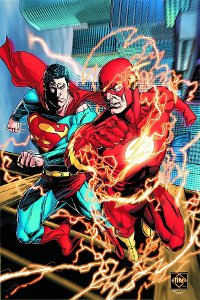So, will the post-Rebirth relaunch of The Flash start with #1, #351, #600…? Dan Didio answers in the latest 20 Answers and 1 Question at Newsarama.
14) The Flash relaunch after Flash: Rebirth. Will that continue with the old numbering, or will it launch with a new #1?
DD: There’s a strength to a #1 when we present it in initial sales, it creates that sense that this is a wonderful jump-on point. Everyone always comes and asks us what the best ways to attract new readers is, and one of the best methods we’ve got is putting a “#1” on something, because it helps the readers to feel that they’re getting in on the ground floor.
Conversely, the continuing numbering, once you get past those early numbers, those higher numbers creates that sense of history for those characters and gives the sense that they have longevity.
So we’re still discussing it, but I imagine you’re going to see a new Flash #1 after the end of Rebirth [emphasis added] – but we are discussing the overall numbering. The more interesting question is, if we do go to the original numbering, what number would we pick it up at? Some people would argue, with a good point, that the Wally West issues should add in there, but should the Bart issues? It’s an interesting argument. Right now, though, I’m thinking you’ll see a Flash #1 for sure.
I actually posed the question of what number picking things up with Flash number should start, and the argument in the room was very clear as to whether or not we would jump from Barry’s original run to this new run of Barry…but for right now, I feel very comfortable in saying that after Flash Rebirth, there will be a new Flash #1 – who that Flash is, I still can’t say.
“I still can’t say.” Yeah. As if anyone believes that they would go to all this effort to bring Barry back with a big event miniseries and relaunch, then put someone else behind the mask.
Also Flash-related in this round: a discussion of in-house advertising and why a sure-bet like Flash: Rebirth got a valuable double-page ad in last month’s DC books. And regarding “co-features,” he points out that they’ve been choosing characters for backup features whom they believe could carry their own ongoing or mini-series.

